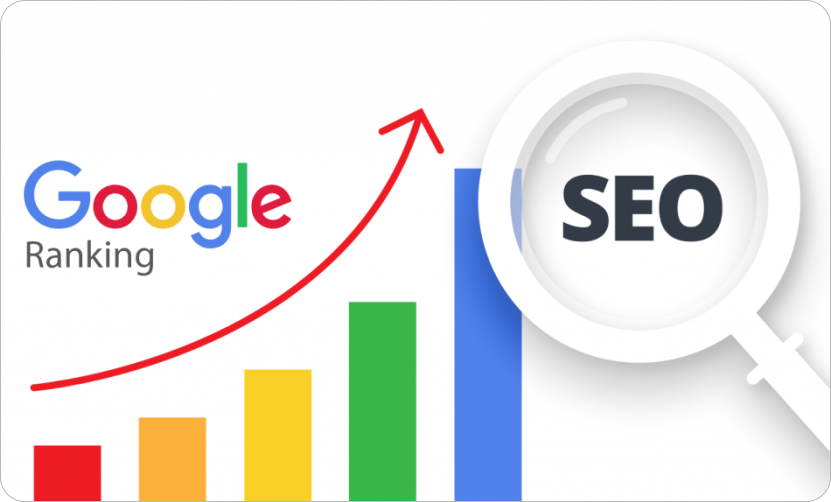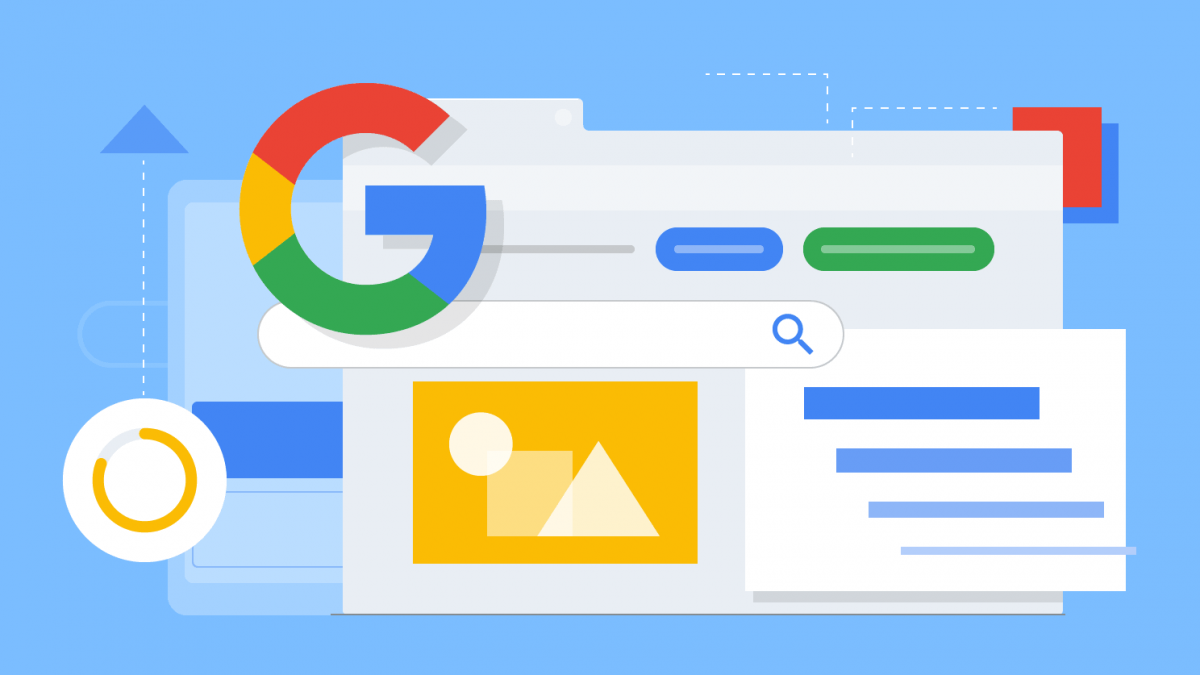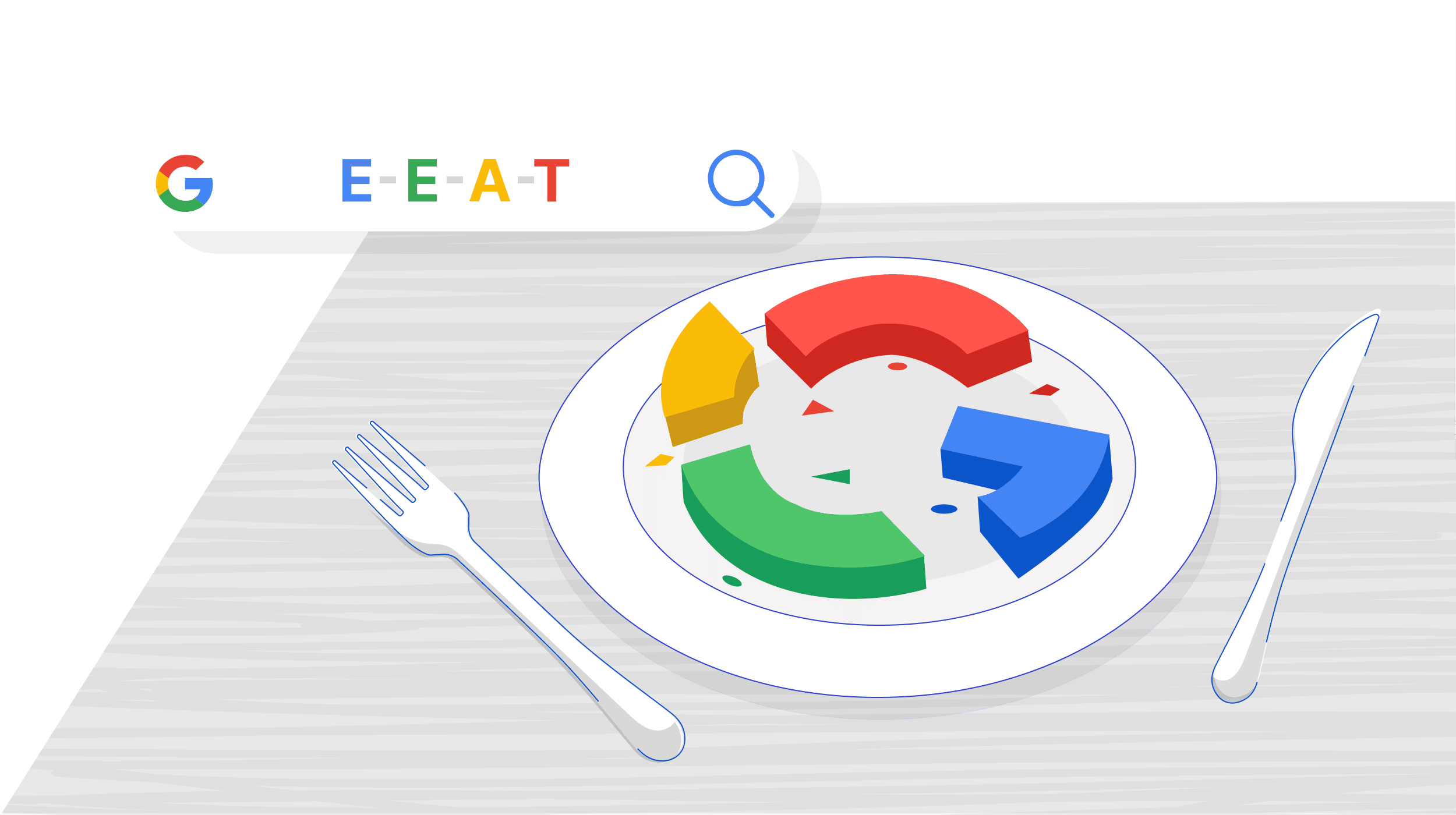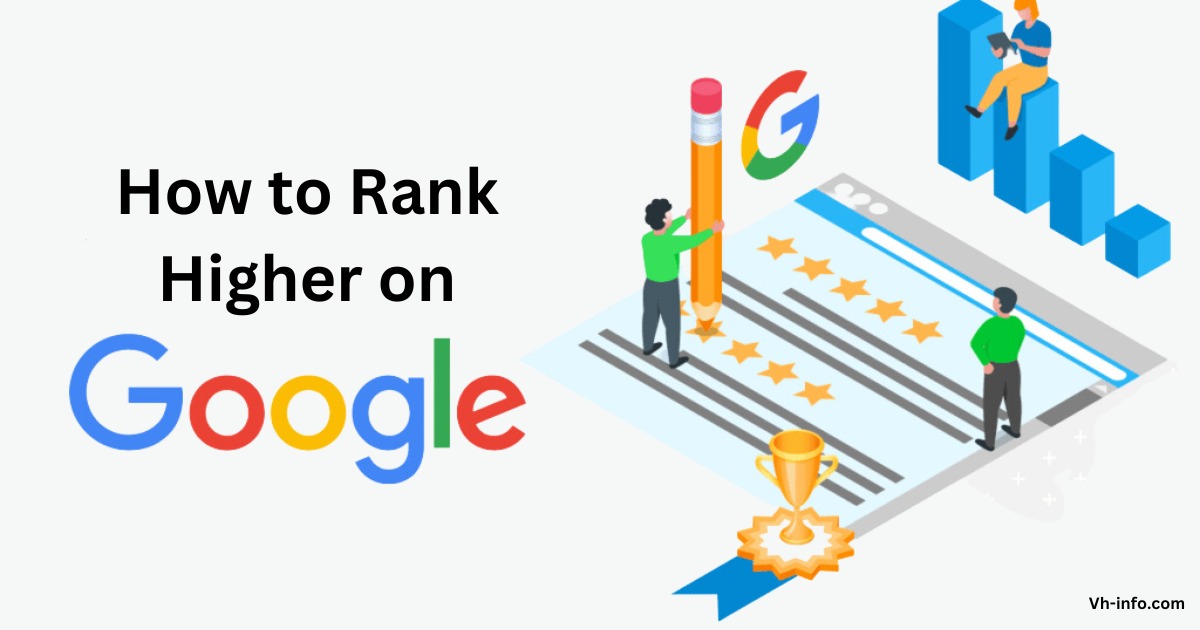Ranking higher on Google is a top priority for any SaaS business looking to drive organic traffic and grow its online presence.
With the right SEO strategies, you can improve your website’s visibility, attract more qualified leads, and ultimately boost conversions.
In this comprehensive guide, we’ll walk you through the key steps to rank higher on Google and dominate the search engine results pages (SERPs).
What is Google Ranking?

Google ranking refers to your website’s position in the search results for specific keywords relevant to your business. The higher your site ranks, the more likely users are to find and click through to your content. Google’s complex algorithm takes into account hundreds of ranking factors, including backlinks and local business factors, to determine the order of search results and to deliver the most relevant, high-quality content to users.
Why is it Important to Rank High on Google?
Ranking high on Google is important for driving organic traffic to your website. Studies show that the top 3 organic search results receive over 50% of all clicks, while results on the second page and beyond receive only a small fraction of clicks.
By securing a top spot in the SERPs, you can:
- Increase brand visibility and credibility
- Drive more qualified traffic to your site
- Generate more leads and conversions
- Establish your brand as an authority in your niche
How Does Google Ranking Work?

Google’s ranking algorithm is constantly evolving, but the core principles remain the same. The search engine aims to provide users with the most relevant, trustworthy, and high-quality results for their queries.
To determine rankings, Google evaluates factors such as:
- Relevance of your content to the search query
- Quality and depth of your content
- User experience and site performance
- Backlinks from authoritative websites
- Engagement metrics like click-through rate and bounce rate
How to Rank Higher on Google?

To rank higher on Google, follow these steps:
Step #1: Improve Your On-Site SEO
On-page SEO is the foundation of any successful Google ranking strategy.
Start by optimizing your title tags, meta descriptions, header tags, and content for your target keywords. Use descriptive, keyword-rich titles and meta descriptions to entice users to click through from the search results.
Ensure your content is well-structured with proper heading tags (H1, H2, etc.) and includes your target keyword naturally throughout. Don’t forget to optimize your images with descriptive alt text to improve accessibility and help search engines understand your visual content.
Step #2: Add LSI Keywords To Your Page
In addition to your primary target keyword, include relevant LSI (latent semantic indexing) keywords throughout your content. LSI keywords are related terms that help Google better understand the context and topic of your page.
For example, if you’re targeting the keyword “SaaS link building“, LSI keywords might include “backlinks for SaaS“, “SaaS SEO“, and “link acquisition strategies“. By including these related keywords naturally in your content, you can reinforce the relevance of your page for your target keyword.
Step #3: Monitor Your Technical SEO
Technical SEO ensures that your website is easily crawlable and indexable by search engines. Regularly audit your site for technical issues like broken links, duplicate content, and crawl errors. Use tools like Google Search Console to identify and fix any technical SEO problems that could be hindering your rankings.
Other important technical SEO factors to consider include:
- Site speed and performance
- Mobile-friendliness and responsive design
- SSL security and HTTPS implementation
- Proper canonicalization and redirects
- XML sitemaps and robots.txt file
Step #4: Match Your Content to Search Intent
To rank higher on Google, your content needs to align with the search intent behind your target keywords.
Search intent refers to the reason why a user is searching for a particular query, which generally falls into one of four categories:
- Informational intent: The user is looking for information or answers to a question.
- Navigational intent: The user wants to find a specific website or webpage.
- Transactional intent: The user is ready to make a purchase or complete an action.
- Commercial investigation: The user is researching products or services before making a purchase decision.
Understanding the search intent behind your target keywords, you can create content that directly addresses the user’s needs and goals.
For example, if you’re targeting a keyword with informational intent, focus on creating comprehensive, educational content that thoroughly answers the user’s question.
Step #5: Reduce Your Bounce Rate
Bounce rate is the percentage of users who leave your website after viewing only one page. A high bounce rate can signal to Google that your content is not relevant or engaging for users, which can negatively impact your rankings.
To reduce your bounce rate and keep users on your site longer:
- Ensure your content delivers on the promise of your title and meta description.
- Use engaging visuals, videos, and interactive elements to encourage users to explore your site further.
- Improve your site’s navigation and internal linking to make it easy for users to find related content.
- Optimize your page load speed to prevent users from bouncing due to slow loading times.
Step #6: Find Even More Keywords to Target
Keyword research is an ongoing process. As you create more content and expand your website, continue to identify new keyword opportunities to target. Use tools like Google Keyword Planner, SEMrush, and Ahrefs to find relevant keywords with good search volume and low competition.
Pro tip: Focus on longer, detailed keywords. They’re less common and easier to rank for. Although these words get fewer searches, they bring in more interested visitors who are likely to convert.
Step #7: Publish Insanely High-Quality Content
To rank higher on Google, you need to consistently publish high-quality, valuable content that meets the needs of your target audience.
Your content should be:
- Comprehensive and in-depth
- Well-researched and backed by data/sources
- Engaging and easy to read
- Optimized for search engines and users
Aim to create the best resource on the web for your target keywords. The more value you provide to users, the more likely they are to engage with and share your content, which can positively impact your rankings.
Step #8: Build Backlinks to Your Site
Backlinks are one of the most important Google ranking factors. When other websites link to your content, it signals to Google that your site is a valuable and authoritative resource.
However, not all backlinks are created equal. Focus on earning high-quality, relevant backlinks from reputable websites in your industry.
Some effective link building strategies for SaaS companies include:
- Guest blogging on industry-relevant websites
- Broken link building and resource page link building
- Creating linkable assets like infographics, tools, and research studies
- Leveraging brand mentions and unlinked mentions
- Participating in industry forums and online communities
At VH-info, we specialize in helping SaaS brands build high-quality backlinks through our targeted link building services. Our experienced team can help you develop a customized link acquisition strategy to improve your site’s authority and rankings.
Step #9: Track and Monitor Your Results
To continually improve your Google rankings, it’s important to track and monitor your SEO performance over time. Use tools like Google Analytics and Google Search Console to measure your organic traffic, keyword rankings, click-through rates, and other key metrics.
Step #10: Include Meaningful Visuals
Including relevant, high-quality visuals can make your content more engaging and shareable, which can indirectly impact your Google rankings. Use images, videos, infographics, and other visual elements to break up your text, illustrate key concepts, and provide additional value to users.
Be sure to optimize your visual content for search engines by including descriptive file names, alt text, and captions. Hosting your videos on YouTube and embedding them on your site can also help you rank for video-based searches.
Step #11: Make Your Information Skimmable
Most users don’t read online content word-for-word. Instead, they scan the page for quick answers and key takeaways.
To make your content more skimmable and user-friendly:
- Use short paragraphs and sentences
- Break up your content with subheadings and bullet points
- Highlight important information with bold or italicized text
- Include a table of contents for long-form content
Advanced Strategies For Google Ranking
If you’re looking to take your Google ranking to the next level, there are several advanced strategies you can utilize. These strategies go beyond the basics of SEO and can help you stand out from the competition.
Leveraging Structured Data For Rich Snippets
Structured data is a standardized format for providing information about a page and classifying its content. By adding structured data markup to your website, you can help Google better understand your content and potentially qualify for rich snippets in the search results.
Rich snippets are enhanced search results that include additional information like review stars, pricing, and product availability. They can make your search listing more eye-catching and enticing to users, leading to higher click-through rates and organic traffic.
Some common types of structured data for SaaS companies include:
- Product schema markup for software offerings
- Review schema for customer testimonials and ratings
- Article schema for blog posts and resources
- FAQ schema for frequently asked questions
- Video schema for embedded videos
To implement structured data on your site, you can use tools like Google’s Structured Data Markup Helper or schema plugins for your CMS.
Understanding and Improving E-E-A-T (Experience, Expertise, Authority, Trustworthiness)

E-E-A-T stands for Experience, Expertise, Authoritativeness, and Trustworthiness. It’s a concept that Google uses to evaluate the overall quality and credibility of a website and its content. To rank higher on Google, it’s important to demonstrate E-E-A-T in your content and across your site.
Some ways to improve your site’s E-E-A-T include:
- Creating comprehensive, well-researched content written by subject matter experts
- Building a strong backlink profile from authoritative websites in your industry
- Showcasing your company’s expertise and experience through case studies, client testimonials, and thought leadership content
- Ensuring your website is secure, up-to-date, and free of technical errors
- Providing clear information about your company, including contact details and customer support options
Common Pitfalls to Avoid in Search Engine Optimization

While there are many strategies to improve your Google ranking, it’s important to be aware of common pitfalls that can negatively impact your SEO efforts. By avoiding these pitfalls, you can ensure that your website is optimized for search engines and has the best chance of ranking higher on Google.
Over-Optimization and Keyword Stuffing
While it’s important to optimize your content for your target keywords, overusing keywords can actually hurt your rankings. Keyword stuffing, or unnaturally repeating keywords throughout your content, is a spammy tactic that can trigger a Google penalty.
Instead of focusing on keyword density, prioritize creating high-quality, relevant content that naturally includes your target keywords. Write for users first and search engines second. If your content sounds unnatural or forced, it’s likely over-optimized.
Ignoring User Experience and Site Performance
User experience and site performance are critical factors in your Google rankings. If your site is slow, difficult to navigate, or not mobile-friendly, users are likely to bounce quickly, sending negative signals to Google.
To improve your site’s user experience and performance:
- Optimize your page load speed by compressing images, minifying code, and leveraging browser caching
- Ensure your site is mobile-responsive and easy to use on all devices
- Simplify your site’s navigation and structure to help users find what they’re looking for quickly
- Provide clear calls-to-action and make it easy for users to contact you or take the next step
Why Prioritize Content Creation Over Off-Page SEO?
Creating great content is vital for boosting your Google rankings. It’s the base of your SEO strategy. Without good content, ranking for keywords becomes tough, regardless of backlinks.
- Quality content brings natural backlinks. When you offer valuable information, other sites will link to yours as a resource.
- Content builds trust and authority with your audience. Regularly posting useful content establishes your brand as an industry leader.
- Content aids in other marketing efforts like social media and email campaigns, drawing more traffic and leads.
- While off-page SEO matters, focusing on content creation first sets a strong foundation for lasting SEO success.
Tips For Ranking Higher in Google

If you’re looking to improve your Google ranking, there are several tips and strategies you can implement. These tips can help you optimize your website and content for search engines, ultimately increasing your chances of ranking higher on Google.
1. Focus on On-Page SEO
Optimize your title tags, meta descriptions, header tags, and content for your target keywords. Use descriptive, keyword-rich titles and meta descriptions to entice users to click through from the search results.
2. Don’t Neglect Technical SEO
Regularly audit your site for technical issues like broken links, duplicate content, and crawl errors. Ensure your site is fast, mobile-friendly, and secure.
3. Don’t Settle For Low-Quality Content (Ever)
To rank higher on Google, you need to consistently publish high-quality, valuable content that meets the needs of your target audience. Don’t cut corners or publish thin, unhelpful content just for the sake of having something to rank.
4. Create Internal Links
Linking to other relevant pages on your site can help search engines understand your site’s structure and distribute link equity throughout your site. Use descriptive anchor text and link to pages that provide additional value to users.
5. Include LSI Keywords
Include relevant LSI keywords naturally throughout your content to reinforce the topic and context of your page for search engines.
6. “E-A-T” More
Demonstrate your site’s expertise, authoritativeness, and trustworthiness through high-quality content, a strong backlink profile, and clear information about your company and authors.
7. Match Search Intent
Ensure your content aligns with the search intent behind your target keywords, whether informational, navigational, transactional, or commercial investigation.
8. Improve Your Bounce Rate
Keep users engaged and on your site longer by providing relevant, engaging content that delivers on the promise of your titles and meta descriptions.
9. Incorporate Video
Embedding relevant videos on your pages can increase engagement and dwell time, sending positive signals to Google. Optimize your videos with descriptive titles, tags, and transcripts.
10. Share Statistical Data
Including relevant statistics and data points in your content can make it more authoritative and shareable. Be sure to cite your sources and keep your data up-to-date.
11. Boost Your Click-Through Rate
Optimize your titles, meta descriptions, and rich snippets to entice users to click through from the search results. A higher organic click-through rate can indirectly improve your rankings.
12. Create a Google My Business Profile
For local SaaS companies, creating a Google My Business profile can help you rank higher in local search results and on Google Maps. Include accurate business information, photos, and customer reviews.
13. Audit Your Brand and Content
Regularly audit your website and content to identify areas for improvement. Look for opportunities to update outdated content, fix broken links, and improve your overall site quality.
14. Keep Track Of Your Results
Use tools like Google Analytics and Google Search Console to track your organic traffic, keyword rankings, and other key SEO metrics. Regularly analyze your data to inform your ongoing optimization efforts.
15. Don’t Be Afraid To Hire Experts
If you’re struggling to improve your Google rankings on your own, consider working with an experienced SEO agency or consultant. Look for a partner with a proven track record of helping SaaS companies achieve their SEO goals.
At VH-info, we specialize in helping SaaS brands improve their Google rankings through targeted link building and content optimization services. Our team of SEO experts can help you develop a customized strategy to drive more organic traffic and qualified leads to your site.
FAQ’s:
How Can I Rank #1 on Google?
Ranking #1 on Google requires a comprehensive SEO strategy that includes keyword research, high-quality content creation, on-page optimization, technical SEO, and link building. Focus on creating the best possible content for your target keywords and building high-quality backlinks to your site.
Can You Pay Google to Rank Higher?
No, you cannot pay Google to rank higher in organic search results. Google’s organic rankings are based on algorithms that evaluate the relevance, quality, and authority of a website’s content. However, you can pay for Google Ads to appear at the top of search results for specific keywords.
Can I Do SEO Without Paying?
Yes, you can implement many SEO strategies on your own without paying for tools or services. This includes keyword research, on-page optimization, content creation, and some link building tactics. However, investing in SEO tools and partnering with experts can help you achieve results faster and more efficiently.
Is Paying For Google Ads Necessary to Rank Higher?
No, paying for Google Ads is not necessary to rank higher in organic search results. Google Ads appear separately from organic listings and do not directly impact your organic rankings.
However, running Google Ads can be a effective way to drive targeted traffic to your site while you work on improving your organic rankings.
How Do I Rank Higher on Google Maps?
To rank higher on Google Maps, claim and optimize your Google My Business listing with accurate business information, photos, and customer reviews. Ensure your business name, address, and phone number (NAP) are consistent across your website and online directories.
Encourage satisfied customers to leave reviews on your Google My Business page to improve your local ranking and increase your chances of appearing on the first page of Google Search.
Are Backlinks Still a Crucial Factor in Ranking Higher on Google?
Yes, backlinks remain one of the most important Google ranking factors. High-quality backlinks from authoritative websites signal to Google that your site is a valuable and trustworthy resource. Focus on building a diverse backlink profile through tactics like guest blogging, broken link building, and creating linkable assets.
How To Improve Your Google Rankings Without Getting Penalized?
To improve your Google rankings without risking penalties, focus on creating high-quality, valuable content through content marketing and SEO marketing that meets the needs of your target audience.
Follow Google’s Webmaster Guidelines and avoid black hat SEO tactics like keyword stuffing, cloaking, and participating in link schemes. Publish relevant, authoritative content that will earn backlinks naturally and improve your search engine rankings.
Can Internal Links Help You To Rank Higher On Google?
Yes, strategic internal linking can help improve your Google rankings by distributing link equity throughout your site, helping Google understand the structure and hierarchy of your content, and providing a better user experience for visitors. Use descriptive, keyword-rich anchor text when linking between related pages on your site.
How Can Utilizing Long-Tail Keywords Impact Your Google Ranking?
Targeting long-tail keywords can help you rank higher on Google for specific, niche topics. Long-tail keywords are often less competitive than broad, high-volume keywords, making it easier to achieve top rankings. Additionally, long-tail keywords typically have higher conversion rates because they attract users with more specific search intent.
How Often Should I Update My Website’s Content?
The frequency of updating your website’s content depends on your industry and the types of content you publish.
In general, it’s a good idea to update your site with fresh, relevant content on a regular basis to keep visitors engaged and signal to Google that your site is active and valuable.
Aim to publish new blog posts, articles, or product pages at least once or twice a month, and update existing content as needed to keep it current and accurate.
Conclusion
To rank higher on Google – it is important for your SaaS business to get more traffic, leads, and sales.
Improve SEO, create relevant content, get quality backlinks, and track performance to boost visibility. SEO requires ongoing effort to stay ahead of competitors. Add value for your audience and update your site and content consistently.
If you need help taking your SaaS company’s SEO to the next level, consider partnering with a reputable agency like VH-info.
Our team of experienced SEO professionals can help you develop and execute a customized strategy to improve your Google rankings, drive more organic traffic, and grow your business.

